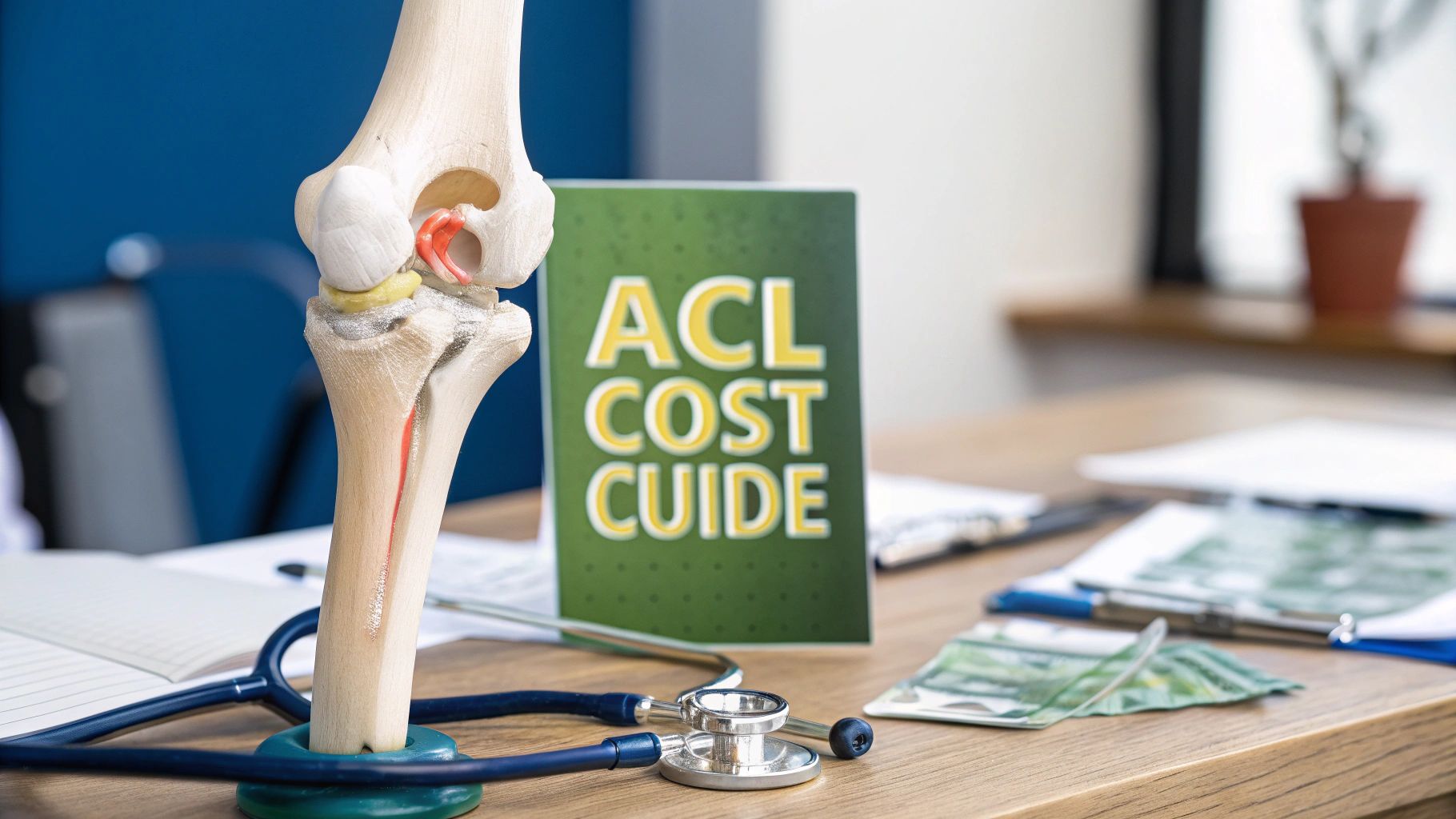.webp)
When you’re looking at private ACL surgery, the cost in the UK usually lands somewhere between £6,000 and £10,000. But that figure isn’t just for the operation itself.
Think of it as an all-inclusive package that covers everything from your first diagnostic scan to the final physiotherapy sessions that get you back in the game. Understanding what’s included is the first step to making sense of the financial side of your recovery.
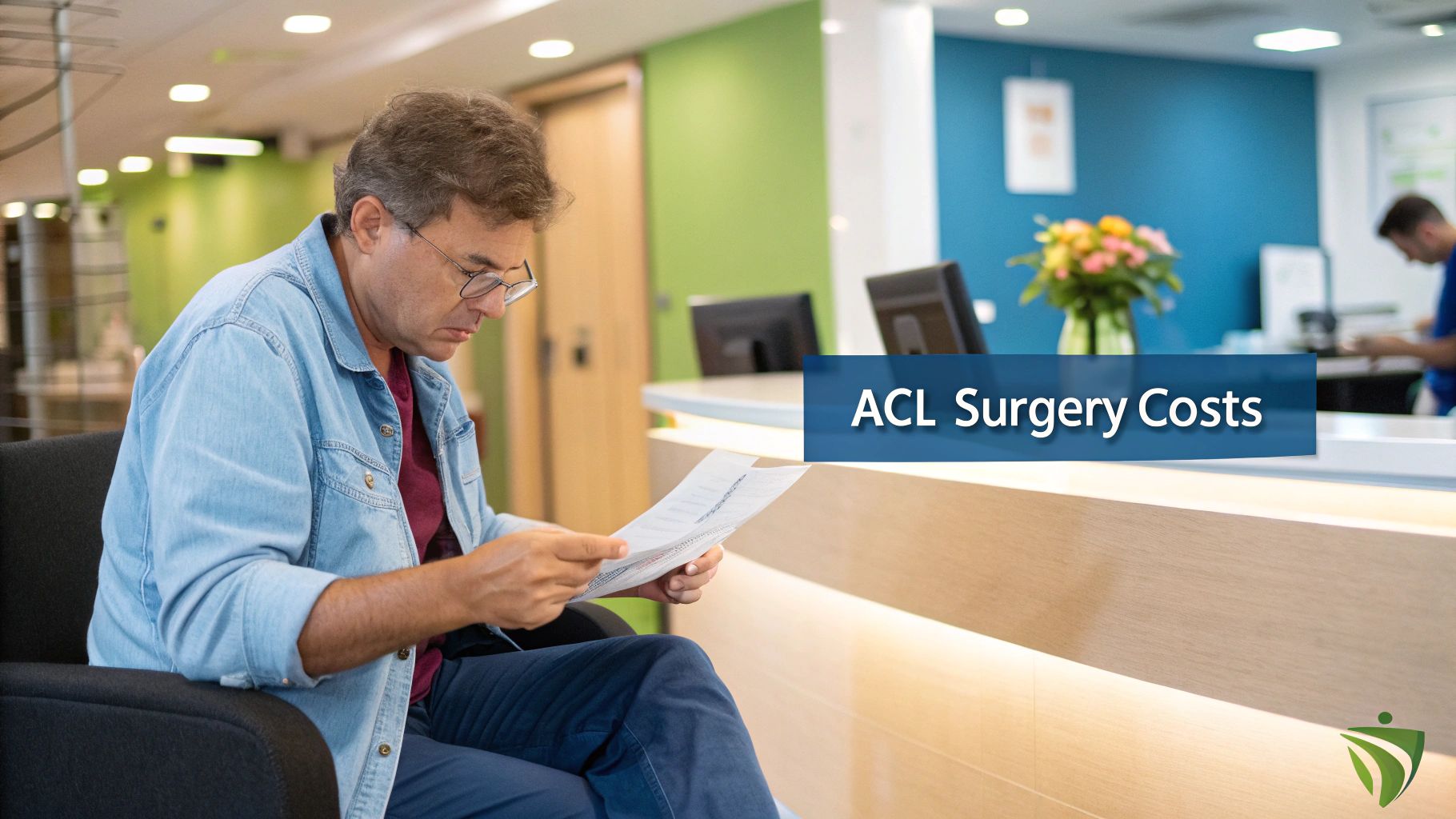
Trying to figure out the costs of private healthcare can sometimes feel like you’re trying to solve a puzzle without the picture on the box. The total price you’re quoted for an ACL surgery is actually the sum of several distinct parts, all working together.
Each component is vital for a safe procedure and a smooth recovery. Seeing them listed out one by one gives you a much clearer picture of exactly where your money is going. It’s like getting a detailed receipt for a major purchase—you want to see the cost of each item, not just the final total. This transparency helps you see the real value behind the price and make a confident decision about your health.
The final bill is really a combination of professional fees, hospital charges, and the all-important aftercare needed to get your knee back to full strength. No single part stands alone; they all connect to create a complete care package.
The main things driving the cost are:
A clear, itemised quote prevents any nasty financial surprises down the line. It puts you in control, allowing you to ask the right questions and understand the full scope of your treatment plan from day one.
To give you a better idea of how this all adds up, let's look at a typical breakdown of the costs.
This table provides an estimated breakdown of the various costs associated with a private ACL surgery package, helping you understand where your money goes.
By seeing these components laid out, you can get a much better sense of the financial commitment involved. For more information on procedures like this, you can explore the details of orthopaedic surgery to see how different treatments are structured and priced.
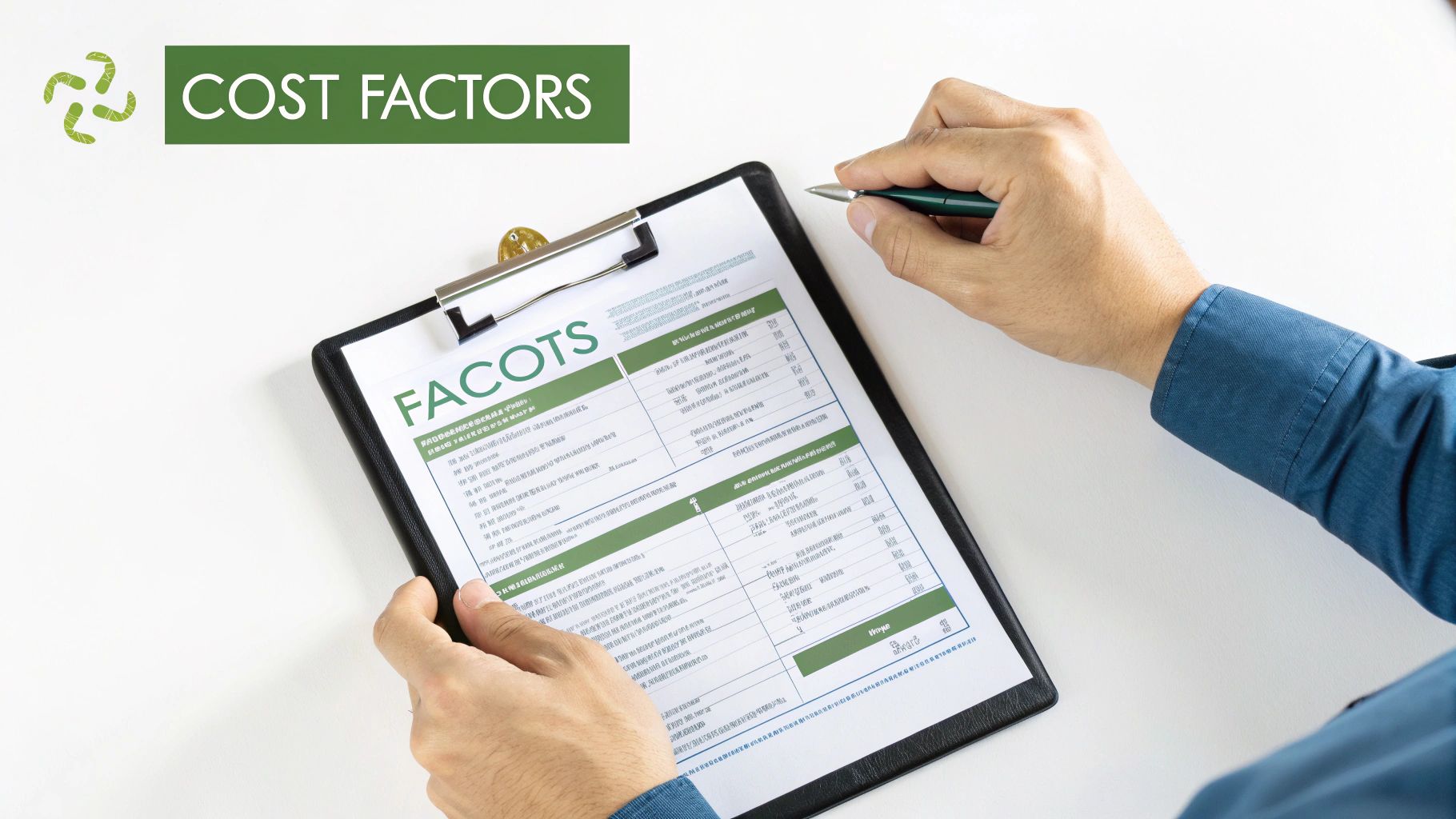
If you've started looking into ACL surgery, you've probably noticed that quotes can vary wildly between clinics. So, why is one price so different from another? The simple answer is that the final ACL surgery cost isn't a single, off-the-shelf number. It’s a combination of several crucial factors.
Think of it like commissioning a bespoke suit. The final price depends on the reputation of the tailor, the quality of the fabric, the complexity of the cut, and even the location of their shop. ACL surgery is much the same; every element plays a role in the total expense.
Getting your head around these variables is the first step. It gives you the confidence to read a quote properly, understand where your money is going, and make an informed decision about your care.
This is arguably the biggest driver of the cost. The experience and reputation of your surgical team matter immensely. A top-tier consultant orthopaedic surgeon who specialises in knee ligament reconstruction will naturally have higher fees than someone with less specific experience. You're paying for their skill, precision, and track record.
Your anaesthetist is just as vital, ensuring your safety and comfort throughout the entire procedure. Their professional fee is a separate but essential part of the overall bill.
When you choose a surgeon, you’re investing in their years of dedicated training, their specific expertise in ACL procedures, and their history of successful outcomes. For many, this is one area where quality is the absolute priority.
These professional fees form the core of your bill. While it's tricky to find public breakdowns of these costs in the UK, looking at trends elsewhere helps paint a picture. In the US, for instance, surgeon and anaesthetist fees make up a huge chunk of the final cost. Understanding this helps you see how all the pieces fit together.
Where you have the operation makes a huge difference to the price. It's no surprise that a leading-edge private hospital in central London will have much higher running costs—and therefore higher charges—than a smaller clinic outside the capital.
The kind of facility matters too. A large hospital with extensive amenities, private overnight rooms, and round-the-clock nursing support will cost more than a dedicated day-case surgical centre. These facility fees cover a whole host of services, including:
These charges are often bundled together into a single ‘hospital fee’. The price reflects the quality of the environment where you'll be recovering. You can see a similar pricing structure when looking at the breakdown of knee replacement costs in the UK, where the choice of facility is also a major factor.
Finally, not all ACL tears are the same. The specific nature of your injury has a direct impact on how complex the surgery will be, and that's reflected in the cost. A straightforward tear needing a standard reconstruction is one thing.
But if there's other damage in the joint, the operation becomes much more involved. For example, if you also have a torn meniscus or damage to other ligaments, the surgeon has to fix these issues during the same procedure.
This means more time in the operating theatre, potentially more sophisticated surgical techniques, and sometimes extra materials or implants. Each of these adds to the final bill, which is why a personalised quote is the only way to get a truly accurate financial picture.
When your consultant talks you through an ACL injury, two key terms are bound to come up: repair and reconstruction. They might sound similar, but they describe two very different surgical routes, and that difference has a huge impact on the final acl surgery cost. Getting your head around the distinction is the first step to understanding your surgical plan and the price tag that comes with it.
Think of your torn ACL like a damaged bit of clothing.
An ACL repair is a bit like stitching up a clean rip in a shirt. If the ligament has torn away from the bone but is otherwise in good shape, the surgeon can simply reattach it. It's a less invasive procedure, preserves your natural ligament, and is generally the less expensive of the two options.
On the other hand, an ACL reconstruction is like needing to sew a whole new patch onto that shirt because the original fabric is too frayed to save. Here, the damaged ligament is completely removed and replaced with a graft—a new piece of tendon taken from another part of your body (an autograft) or from a donor (an allograft). This is a more complex job and the more common approach, which is reflected in its higher cost.
So, why does reconstruction cost more? It really boils down to three things: surgical complexity, time in the operating theatre, and the materials used. A reconstruction is just a more involved operation. The surgeon first has to harvest and prepare a graft before they can even begin attaching it inside your knee joint.
This extra step adds time to the surgery. More time on the table means higher fees for the surgeon, the anaesthetist, and the use of the hospital's facilities.
The graft itself is another major cost factor. While using your own tissue (autograft) is common, sometimes a donor graft (allograft) is the better clinical choice. These allografts are specially processed and screened, which can add a significant amount to the total bill.
This infographic gives you a clear visual breakdown of how the two procedures stack up.
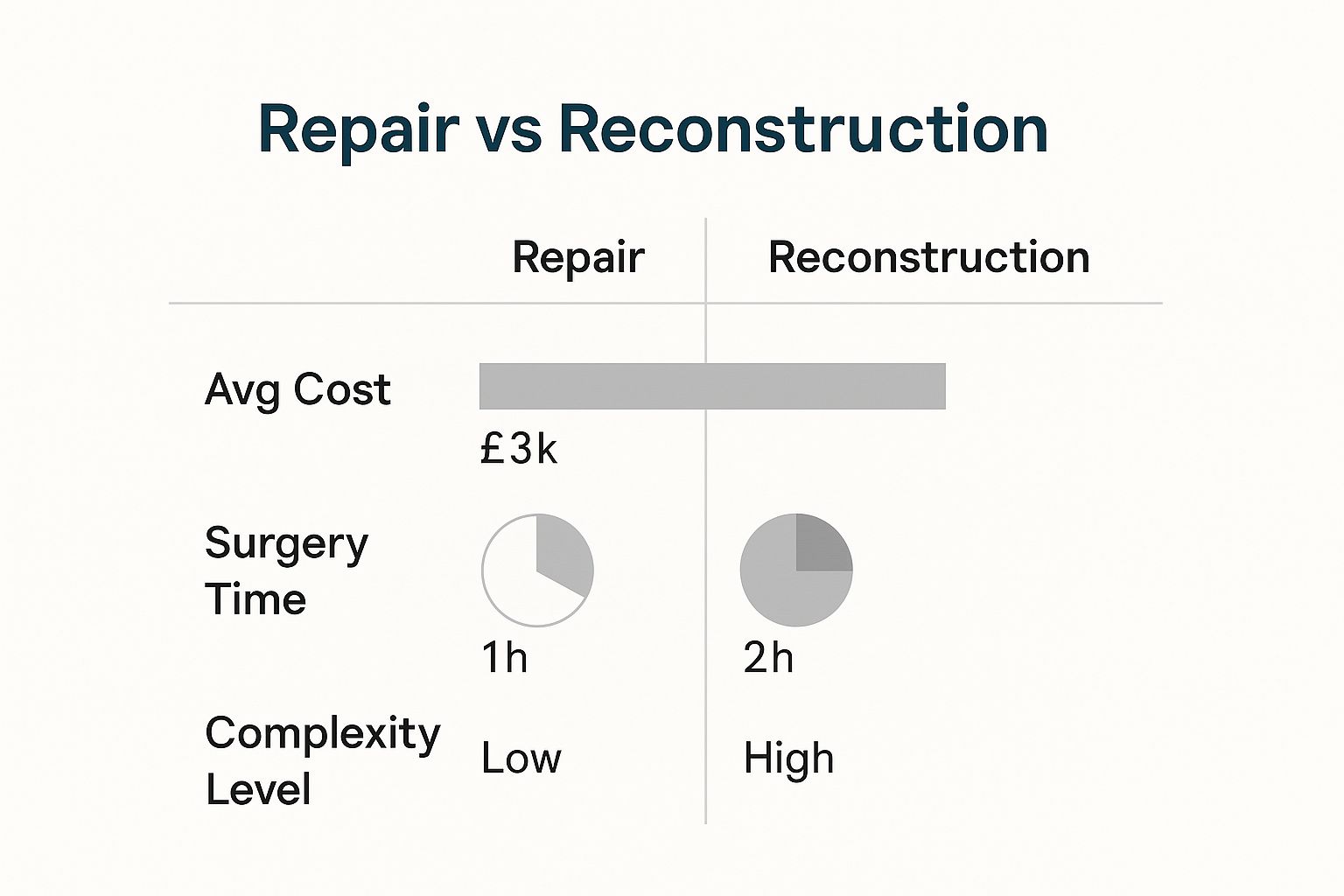
As you can see, reconstruction isn't just more expensive; it's a longer and more complex surgery than a straightforward repair.
To help you see the differences at a glance, here’s a side-by-side comparison of the factors that influence the cost of each procedure.
This table makes it clear that while both aim to stabilise the knee, the resources and complexity involved in a reconstruction are what really drive up the price.
Let’s dig into the numbers a bit more. The cost difference between an ACL repair and a reconstruction in the UK can easily run into thousands of pounds, and that gap is down to the specific techniques and materials needed for each one.
For example, a reconstruction that uses a donor allograft can add up to £6,000 to the total cost, simply because of the meticulous processing and preservation that graft requires. Knowing these details helps you make sense of any quote you receive, so you can see exactly what you're paying for.
It's important to remember that your surgeon will always recommend the procedure that gives you the best chance of long-term stability and function. For most complete tears, that's going to be a reconstruction.
Your consultant's primary goal is to restore your knee's stability for the long haul. While repair is an option in specific cases, reconstruction is often the gold standard for getting active individuals back to their pre-injury level of performance.
This helps frame the cost not just as a bill, but as an investment in a durable, long-lasting fix for your knee. This is especially true for athletes and active people dealing with sports injuries, where a robust recovery is everything. You can find out more by reading our guide on the treatment for sports-related injuries.
Ultimately, your surgeon’s recommendation will be based entirely on your specific injury, your age, and your activity level to make sure you get back on your feet safely and effectively.
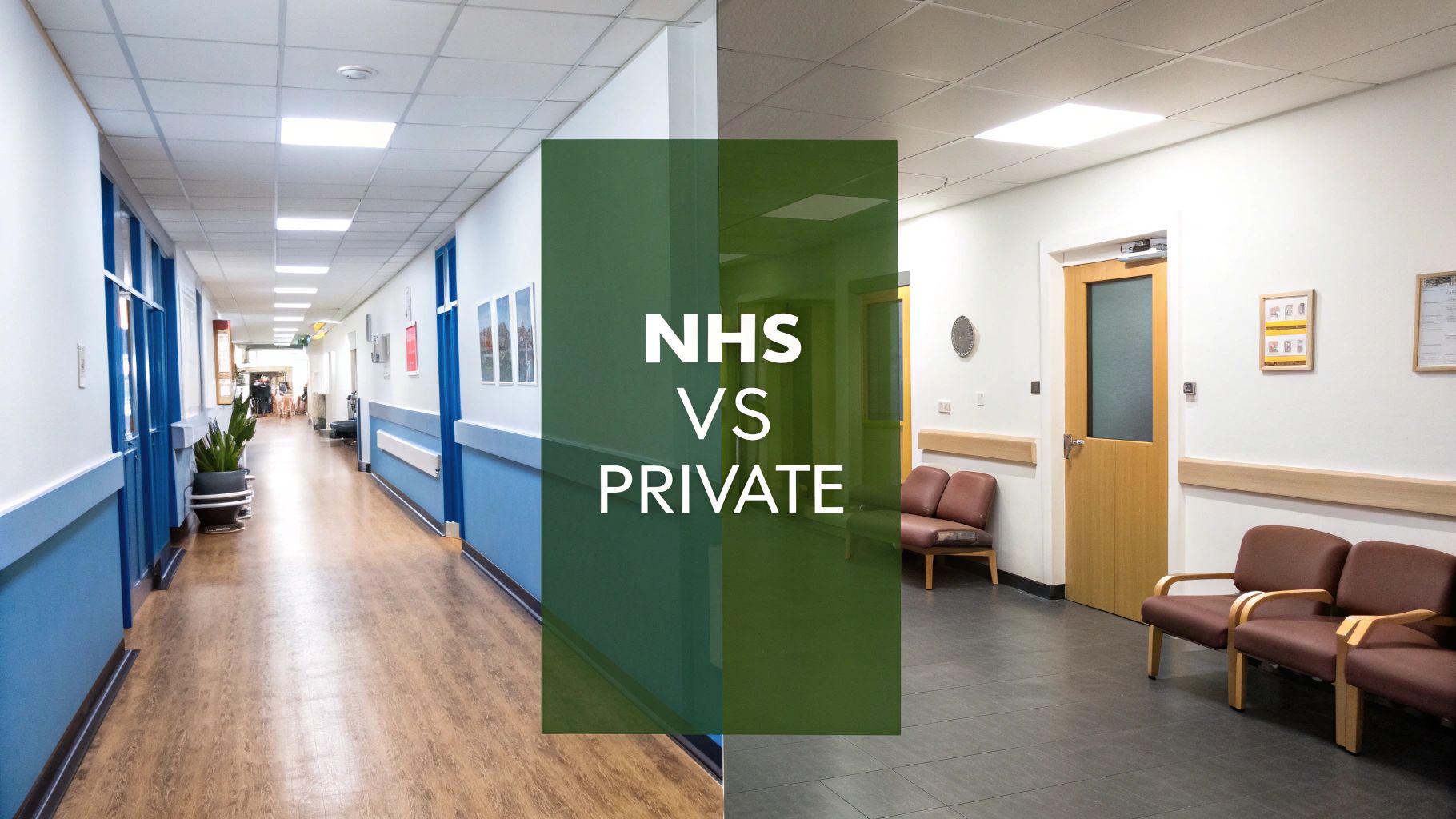
When you're dealing with an ACL injury in the UK, you quickly find yourself at a crossroads. Two very different paths lie ahead: treatment through the National Health Service (NHS) or going down the private healthcare route.
It’s a decision that really boils down to a classic trade-off between time and money. There's no single "correct" answer here; the best path is the one that fits your life, your urgency, and your budget.
Let’s be clear: the biggest advantage of choosing the NHS for your ACL surgery is enormous. It’s free at the point of use. For many people, this fact alone makes it the only realistic option. The quality of care you'll receive is excellent, with highly skilled surgeons performing these operations day in, day out.
The catch? Time. The journey from your GP appointment to the operating table can be a long and winding road. You’re almost certain to face significant waiting lists at every single stage.
This process typically involves:
This drawn-out timeline can be incredibly frustrating, especially if you’re an active person desperate to get back to sport or if your job depends on being physically fit.
Going private completely flips the script. The main hurdle here is the significant ACL surgery cost, as you'll be funding the entire procedure yourself, either from your own pocket or through a private medical insurance policy.
What do you get for that financial investment? Speed and control. The private pathway is dramatically faster. You can often see a top specialist within days, get an MRI booked for the same week, and have your surgery scheduled in a matter of weeks, not months. If you want a better sense of how it all works, you can learn more about what private healthcare is and what it involves.
Private care offers a streamlined process built for efficiency. It lets you schedule your recovery on your own terms, minimising the disruption to your life, work, and sporting goals.
It's not just about speed, though. You also get far more choice. You can research and hand-pick a consultant surgeon who specialises in ACL reconstructions. You also get the flexibility to schedule appointments and the surgery itself to fit around your work and family commitments. For many, this level of personal control is a huge plus.
Ultimately, the choice comes down to what you prioritise most. If your primary concern is avoiding a large bill and you have the patience to handle a potentially long wait, the NHS provides world-class care without the financial sting.
However, if getting back to your normal life as quickly as possible is your top priority, and you have the funds—through savings or insurance—the private route offers a highly efficient, patient-focused alternative. It all comes down to weighing the cost against the waiting time to figure out the right recovery journey for you.
Looking at the ACL surgery cost as just a one-off bill is missing the bigger picture. A better way to see it is as a strategic, long-term investment in your future health, mobility, and overall quality of life. The initial cost might feel significant, but the value it brings over years—and even decades—is often immeasurable.
Think of it like deciding whether to fix a serious problem with your car's engine. You could keep making small, temporary fixes, but the real issue won't go away. It’ll likely cause more damage and end up costing you more down the road. Committing to a proper repair now prevents a complete breakdown later. ACL surgery works in much the same way for your knee.
Putting off or skipping surgery for a complete ACL tear isn't a zero-cost decision. An unstable knee is a massive risk factor for further, more serious joint damage. Every time your knee gives way, you risk damaging other crucial structures, like the meniscus or the articular cartilage that keeps the joint moving smoothly.
This repeated micro-trauma can speed up the onset of osteoarthritis, a painful and degenerative joint condition. The future costs of managing chronic arthritis—from pain medication and ongoing physiotherapy to potentially needing a full knee replacement—can easily dwarf the initial cost of an ACL reconstruction.
Investing in surgery now helps restore stability, protecting the delicate ecosystem inside your knee from this domino effect of future problems.
Beyond the purely medical upside, the return on your personal well-being is enormous. An unstable knee can force you to abandon the activities you love, whether that’s playing football on a Sunday, going for a run, or just keeping up with your kids in the park.
This loss of activity can have a huge knock-on effect on both physical and mental health. Restoring your knee's function lets you:
The real value of ACL surgery is measured not just in pounds, but in the freedom to live an active, unrestricted life. It's an investment in your ability to move confidently and without pain for years to come.
This isn’t just opinion; it's backed by clinical evidence. In the UK, the cost-effectiveness of surgical reconstruction is a key factor. Research funded by the National Institute for Health Research (NIHR) found that surgery can be more successful and cost-effective than rehabilitation alone. One study put the value of surgery at £19,346 per quality-adjusted life year (QALY)—a metric used to measure health outcomes—suggesting it's a worthwhile investment within NHS thresholds. You can read the full findings on the cost-effectiveness of ACL surgery.
So, while the upfront cost is a serious consideration, the long-term benefits of a stable, functional knee often make ACL surgery a very wise investment indeed.
Opting for private ACL surgery gives you back control over your timeline and choice of surgeon, but it naturally brings up a big question: how do you pay for it? Figuring out the finances is the final piece of the puzzle, but it doesn't have to be a headache.
Thankfully, there are two clear paths to cover the ACL surgery cost: using your private health insurance or funding it yourself. Let's break down what each route involves so you can move forward with a clear plan and focus on what really matters—your recovery.
If you have a private health insurance policy, this is your first port of call. But don't assume you're automatically covered. You'll need to do a little homework first, and the most important step is to speak directly with your provider before committing to anything.
When you ring them, make sure you have your policy number to hand. It’s vital to ask the right questions now to avoid any nasty surprises down the line.
Here’s what you need to ask your insurer:
Once you’ve confirmed you’re covered, the next step is getting pre-authorisation. Your consultant’s secretary will usually guide you through this, sending the necessary medical details and procedure codes to your insurer. This official approval is your green light, confirming your insurer will cover the agreed costs.
If you don't have insurance, or your policy won’t cover the full cost, self-funding is the other main option. It might sound intimidating, but private hospitals have made this a surprisingly straightforward process.
Many private hospitals now offer fixed-price packages for self-paying patients. These bundle all the core costs—the surgeon, anaesthetist, hospital fees, and initial aftercare—into a single, predictable figure. This gives you complete clarity and protects you from unexpected bills.
These packages offer fantastic peace of mind, but what if you don't have the full amount ready to go? You still have options. Many healthcare providers have partnerships with finance companies to offer medical loans or structured payment plans. This lets you spread the cost over several months or even years, making a significant expense feel much more manageable.
For anyone looking to explore their financing options further, there are plenty of strategies for making private healthcare more affordable that can help you plan effectively.
Trying to get your head around the financial side of ACL surgery can feel as daunting as the operation itself. Even with a rough idea of the total figure, you’re bound to have specific questions. Let's clear up the most common ones.
Think of this as your financial pre-op checklist. Getting these details sorted now means you can put all your energy into what really matters later: your recovery.
This is the big one, and the honest answer is: probably not every penny. While a good private health insurance policy should cover the lion's share of the core surgical costs—like the consultant’s fees and hospital stay—you almost always have to account for shortfalls.
Most policies come with an excess, which is the fixed amount you pay out of your own pocket before your insurer steps in. On top of that, many plans place limits on post-operative care.
For example, your policy might only cover a certain number of physiotherapy sessions. Since a full ACL recovery can take nine months or more of dedicated rehab, you could find yourself budgeting for extra sessions once you’ve used up your allowance. It’s essential to read the small print of your plan.
While reputable clinics are upfront with their pricing, it's always smart to be aware of potential extras. The main "hidden" costs are often for things that fall just outside a standard surgical package.
A fixed-price surgical package gives you fantastic peace of mind, but it’s vital to understand exactly what is and isn’t included. The best way to avoid surprises is to ask for a detailed breakdown from the get-go.
Potential extra expenses might include:
Physiotherapy isn’t just an optional add-on; it’s the single most important part of your long-term success. Your initial surgical package often includes the first block of sessions (usually covering the first six to eight weeks), but you’ll need ongoing physio for many months after that.
On average, a single private physiotherapy session in the UK will set you back between £50 and £90. Over a nine-month recovery, the total cost for this essential rehabilitation can easily top £1,000. Factoring this ongoing expense into your total budget is an absolute must for getting back to full fitness.
At The Vesey, we believe in complete transparency, providing clear, all-inclusive quotes to help you plan your recovery with confidence. To learn more about our patient-focused approach and our specialist orthopaedic services, visit us at https://www.thevesey.co.uk.

